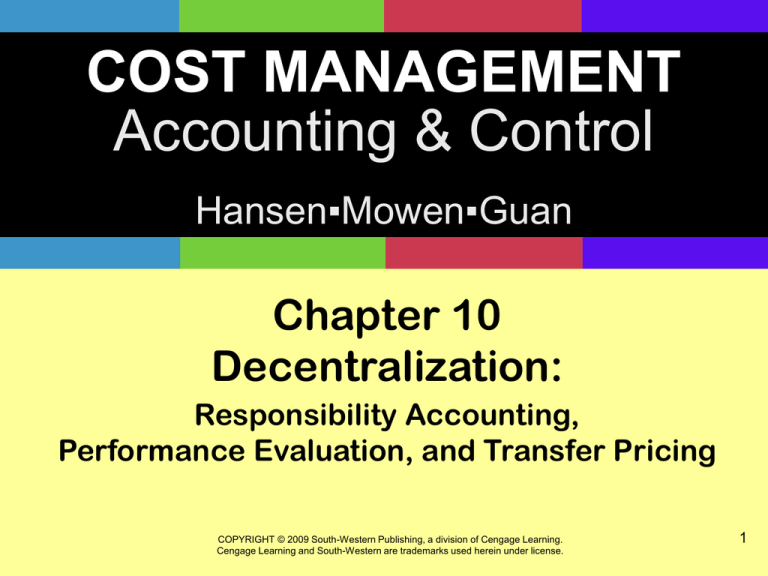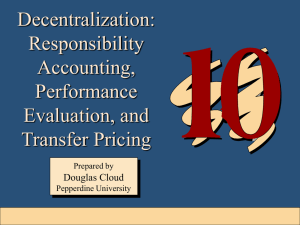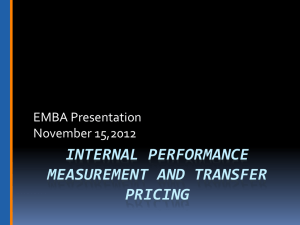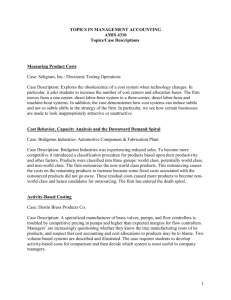Responsibility Accounting
advertisement

COST MANAGEMENT Accounting & Control Hansen▪Mowen▪Guan Chapter 10 Decentralization: Responsibility Accounting, Performance Evaluation, and Transfer Pricing COPYRIGHT © 2009 South-Western Publishing, a division of Cengage Learning. Cengage Learning and South-Western are trademarks used herein under license. 1 Study Objectives 1. Define responsibility accounting, and describe the four types of responsibility centers. 2. Explain why firms choose to decentralize. 3. Compute and explain return on investment (ROI), residual income (RI), and economic value added (EVA). 4. Discuss methods of evaluating and rewarding managerial performance. 5. Explain the role of transfer pricing in a decentralized firm. 6. Discuss the methods of setting transfer prices. 2 Responsibility Accounting Responsibility accounting – measures the results of each responsibility center – compares those results with some measure of expected or budgeted outcome. 3 Responsibility Accounting Types of Responsibility Centers – Cost center: only responsible for costs – Revenue center: only responsible for revenues – Profit center: responsible for both revenues and costs – Investment center: responsible for revenues, costs, and investments 4 Decentralization Reasons for Decentralization – Better access to local information – More timely response – Focusing of central management – Training and evaluation of segment managers – Motivation of segment managers – Enhanced competition 5 Measuring the Performance of Investment Centers Return on investment (ROI) the most common measure of performance for an investment center ROI = Operating income ÷ Average operating assets = (Operating income ÷ Sales) (Sales ÷ Average operating assets) = Operating income margin Operating asset turnover Margin: portion of sales available for interest, taxes and profit Operating income Sales Turnover: how productively assets are being used to generate sales Sales Average operating assets 6 Measuring the Performance of Investment Centers 7 Measuring the Performance of Investment Centers 8 Measuring the Performance of Investment Centers Advantages of the ROI measure – Helps managers focus on the relationship between sales, expenses and investment. – Encourages cost efficiency. – Discourages excessive investment in operating assets Disadvantages of the ROI measure – Discourages managers from investing in projects decreasing divisional ROI but increasing profitability of the company overall. – Encourages managers to focus on the short-term at the expense of the long-term. 9 Measuring the Performance of Investment Centers Residual income the difference between operating income and the minimum dollar return required on a company’s operating assets Residual = Operating - Minimum rate of return Income Income Operating assets 10 Measuring the Performance of Investment Centers Advantages of Residual Income Project I Residual income = $1,300,000 - (0.10 $10,000,000) = $1,300,000 - $1,000,000 = $300,000 Project II Residual income = $640,000 - (0.10 $4,000,000) = $640,000 $400,000 = $240,000 11 Measuring the Performance of Investment Centers Disadvantages of Residual Income ROI is an absolute measure of return; it does not discourage myopic behavior Division A Division B Average operating assets $15,000,000 $2,500,000 Operating income $ 1,500,000 $ 300,000 1,200,000 200,000 300,000 $ 100,000 Minimum returna Residual income Residual returnb a0.08 $ 2% 4% × Operating assets. bResidual income divided by operating assets. 12 Measuring the Performance of Investment Centers Economic value added (EVA) after-tax operating profit minus the total annual cost of capital. After-tax EVA = operating - Weighted average cost of capital Total capital employed income Total capital employed = capital assets plus other expenditures meant to have a long-term payoff 13 Measuring the Performance of Investment Centers EVA Example Amount Mortgage bonds Unsecured bonds Common Stock Total Sources Percent After-Tax Weighted Cost Cost $ 2,000,000 13.3% 0.0480 0.006 3,000,000 20.0% 0.0600 0.012 10,000,000 66.7% 0.1200 0.080 $ 15,000,000 Weighted average cost of capital 0.098 Capital employed $ 15,000,000 Cost of capital $ 1,476,000 14 Measuring the Performance of Investment Centers EVA Example (continued) Furman’s EVA is: After-tax profit Less: Weighted average cost of capital EVA $1,583,000 (1,470,000) $ 113,000 The positive EVA means that Furman, Inc., earned operating profit over and above the cost of the capital used. 15 Measuring the Performance of Investment Centers Behavioral Aspects of EVA Hardware Division Sales Cost of goods sold Gross profit Divisional selling and administrative expenses Operating income Average cost of capital = 11% Capital used Cost of capital Software Division $5,000,000 2,000,000 $3,000,000 $2,000,000 1,100,000 $ 900,000 2,000,000 $1,000,000 400,000 $ 500,000 $10,000,000 $1,100,000 $2,000,000 $220,000 16 Measuring the Performance of Investment Centers Behavioral Aspects of EVA Tends to focus on long-run Hardware Discourages myopic behavior Division Operating income Less: Cost of capital EVA Software Division $1,000,000 $500,000 1,100,000 220,000 $ (100,000) $280,000 Positive EVA = wealth is being created Negative EVA = capital is being destroyed 17 Measuring and Rewarding the Performance of Mangers • Measuring performance in the MNC – Evaluate the division – Evaluate the manger • Base on factors where control exists • Do not evaluate on factors over which there is no control (currency fluctuations, income taxes, etc.) 18 Measuring and Rewarding the Performance of Mangers • MNC divisional ROIs impacted by – International vs domestic environmental conditions (economic, legal, political, social, etc.) • Multiple measures of performance for MNC divisions – Consider market potential and market share – Residual income and ROI should not be the sole measures for MNC divisions 19 Measuring and Rewarding the Performance of Mangers • Managerial rewards – Separation of ownership and management creates the possibility that managers may not operate the business in the best interest of the shareholders • Managers do not exert the most productive effort for the company • Managers may spend company resources on perquisites – A well-structured incentive compensation system encourages goal congruence 20 Measuring and Rewarding the Performance of Mangers • Cash compensation – Reward good management performance by granting periodic raises • Become a permanent part of the compensation package – Bonuses provide more flexibility • Income-based compensation may encourage dysfunctional behavior. – A combination of salary and bonus keeps salaries fairly level and allows bonuses to fluctuate with reported income. 21 Measuring and Rewarding the Performance of Mangers • Stock-based compensation – A stock option is the right to buy a certain number of shares of the company’s stock, at a particular price and after a set length of time. – Stock options are offered to managers • They become owners (shareholders) of the company • Ownership encourages goal congruence – The price of the stock is usually set to approximate market price at the time of issue. • If the stock price rises in the future, the manager may exercise the option. 22 Measuring and Rewarding the Performance of Mangers • Issues to consider – Single-measure outcomes encourage gaming behavior – The Big Bath – Cash bonuses and stock options encourage short-term orientation by management • Noncash compensation – Autonomy – Perquisites 23 Transfer Pricing Transfer prices are the prices charged for goods produced by one division and transferred to another. The price charged affects the revenues of the transferring division and the costs of the receiving division. 24 Transfer Pricing • A transfer pricing system should satisfy three objectives: – Accurate performance evaluation – Goal congruence – Preservation on divisional autonomy 25 Transfer Pricing Opportunity cost approach identifies – The minimum price that a selling division would be will to accept Floor: leaves the selling division no worse off for having sold to an internal division – The maximum price that the buying division would be willing to pay Ceiling: leaves the buying division no worse off for having purchased from an internal division 26 Transfer Pricing 27 Setting Transfer Prices A good should be transferred internally whenever the opportunity cost (minimum price) of the selling division is less than the opportunity cost (maximum price) of the buying division. 28 Setting Transfer Prices • Commonly used policies – Market price • Price in an outside, perfectly competitive, market – Negotiated transfer prices • Agreed to only if the opportunity cost of the selling division is less than the opportunity cost of the buying division – Cost-based transfer prices • Variable cost • Full (absorption cost) 29 Setting Transfer Prices Negotiated transfer prices Example 1: Avoidable Distribution Costs 30 Setting Transfer Prices Negotiated transfer prices Example 1: Avoidable Distribution Costs 31 Setting Transfer Prices Negotiated transfer prices Example 1: Avoidable Distribution Costs 32 Setting Transfer Prices Negotiated transfer prices Example 2: Excess Capacity 33 Setting Transfer Prices Negotiated transfer prices Example 2: Excess Capacity 34 Setting Transfer Prices • Negotiated Transfer Prices – Disadvantages • Time consuming – Advantages • Negotiation helps ensure goal congruence • Comparable negotiating skills support motivation and accurate performance measures 35 Setting Transfer Prices • Cost-Based Transfer Prices – Forms • Full-cost transfer pricing • Full cost plus markup • Variable cost plus fixed fee – Propriety of use • Impact on divisional profit is negligible • Ease of cost measurement is beneficial • Result of negotiations 36 Setting Transfer Prices • Transfer Pricing and the MNC – Performance evaluation – Optimal determination of income taxes • Shift costs to high-tax countries • Shift revenues to low-tax countries 37 Setting Transfer Prices 38 Setting Transfer Prices • IRS Code §482 – Requires arms’-length transactions – Allowable pricing methods • • • • Comparable uncontrolled price method Resale price method Cost-plus method Negotiated between the company and the IRS • Income taxes are universal – Market-based transfer prices 39 COST MANAGEMENT Accounting & Control Hansen▪Mowen▪Guan End Chapter 10 COPYRIGHT © 2009 South-Western Publishing, a division of Cengage Learning. Cengage Learning and South-Western are trademarks used herein under license. 40




